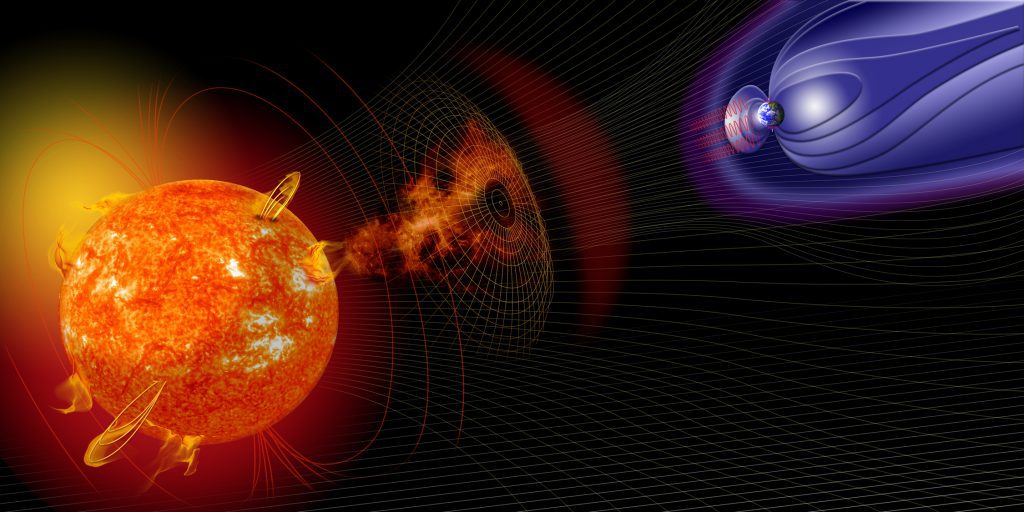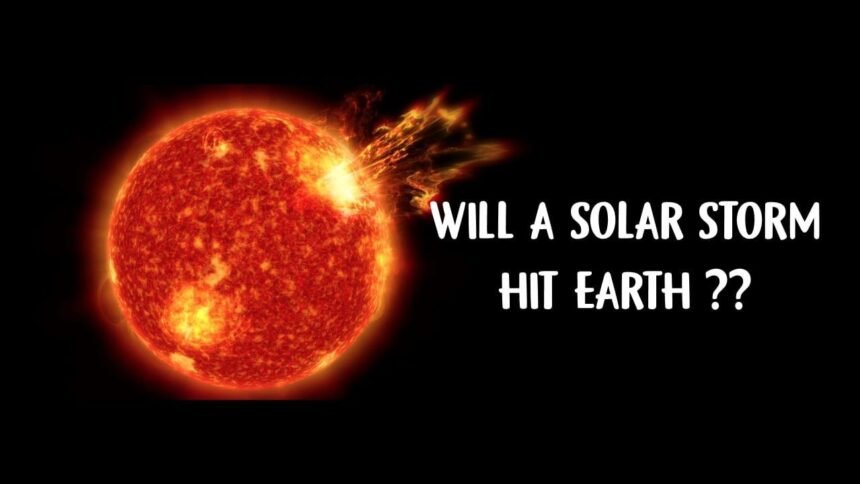When you hear the term “storm,“ what comes to mind? Your thoughts may be filled with images of rolling dark clouds. The roar of thunder is echoing in your ears. You might be looking up at the sky for lightning bolts.
What about a solar storm, though? Would you think solar storms occasionally bombard the Earth and that you are unlikely to see or hear any of the above? Well, we are here to clear up all your doubts. So, let’s begin.
●⫸ What is a Solar Storm?
A solar storm, also known as a geomagnetic storm, is a term used to describe the atmospheric impacts felt on Earth due to activities on the Sun.
You probably imagine the Sun as a brilliant, constant source of light. It’s an enormous molten gaseous ball that’s always changing.
When a solar storm hits the Earth, it typically creates a bright “northern lights” display in sections of the atmosphere visible around the Arctic Circle. Solar storms can also disrupt satellites and other forms of electronic communication.
A large explosion in the Sun triggers solar storms. Solar flares are enormous explosions that can be as enormous as billions of atomic bombs!
Solar flares are frequently accompanied by the discharge of massive jets of charged plasma traveling millions of miles per hour. These streams are called coronal mass ejections, or CMEs.
On the other hand, we have a Geomagnetic storm.
Our magnetic field creates the Earth’s magnetosphere, which shields us from many of the particles that the sun generates. The magnetosphere is buffeted when a CME or high-speed stream hits Earth.
When the approaching solar magnetic field is directed south, it interacts strongly with the Earth’s magnetic field, which is oriented in the opposite direction.
The Earth’s magnetic field is then peeled apart like an onion, allowing energetic solar wind particles to pour down the field lines and strike the atmosphere above the poles, causing a Geomagnetic storm.

A Geomagnetic storm is defined as a rapid decrease in the strength of the Earth’s magnetic field at its surface. The magnetic field drops for 6 to 12 hours before gradually recovering over several days.
Read also: 6 Best Places to See the Northern Lights
●⫸ Reasons for the formation of Solar Storms
Solar storms occur when the Sun emits massive spurts of energy through solar flares and coronal mass ejections. At a speed of nearly three million miles per hour, these occurrences propel a flood of electrical currents and magnetic fields toward the Earth.
Variations in the sun’s magnetic field create these massive solar storms.
Solar flares occur when accelerated charged particles, primarily electrons, collide with the plasma medium. Evidence suggests that magnetic reconnection causes this extraordinary acceleration of charged particles.

Magnetic reconnection can occur on solar arcades, a series of loops that follow magnetic lines of force. This explains why solar flares usually emerge from the Sun’s active regions, which have significantly stronger magnetic fields
Although the origin of a flare’s energy is well known, the mechanisms that cause it are yet unknown. It’s not obvious how the particles’ magnetic energy is transformed into kinetic energy or that some atoms can be accelerated.

Read More:
Rare Earth Elements (REE) | Facts, Uses, and Name of all 17 Rare Earth Elements
●⫸ Intensity & Measurement
A solar flare is a powerful burst of electromagnetic radiation in the Sun’s atmosphere. Flares are common in active regions, and coronal mass ejections, solar particle events, and other solar events frequently follow them.
A clear observable solar storm needs an energy release of around 1020 joules, whereas a large event can emit up to 1025 joules. Although they were first discovered in the visible electromagnetic spectrum, particularly in the hydrogen H-alpha emission line, they can currently be identified from radio waves to gamma rays.
A magnetometer device can also detect minor changes in the Earth’s magnetic field induced by solar storms. The intensity of the geomagnetic storm is measured by the US National Oceanic and Atmospheric Administration‘s G-scale, which ranks storms from G1 to G5, with G1 being the weakest and G5 being the strongest.
Following an 11-year cycle, the frequency of solar flares fluctuates from several per day when the Sun is extremely ‘active’ to less than once per week when the Sun is ‘dormant.’ Flares of a larger size are less common than flares of a smaller size.
●⫸ When did the last solar storm hit earth?
The last solar storm that hit earth massively was said to be racing across space and was expected to reach Earth on Wednesday, February 2, 2022.
Following an M1-class solar flare, a coronal mass ejection, a strong explosion near the sun’s surface, burst into space in the early hours of Saturday morning (Jan. 30).
According to the European Space Agency, M-class solar flares medium-sized space weather events that could have produced temporary radio blackouts on Earth.
According to astronomer Tony Phillips of Spaceweather.com, the burst of the last solar storm that hit the earth, which emanated from a sunspot, was particularly long-lasting, lasting more than four hours.
Spaceweather.com predicted that a G2-class geomagnetic storm could occur as a result of the CME’s arrival to Earth. It was forecasted as a moderate-class “low-hazard” geomagnetic storm.
But the breakdown and reentry of 40 SpaceX Starlink satellites that had been recently set up and were in low Earth orbit were caused by a minor solar particle and geomagnetic storm.
●⫸ What do solar storms do to earth?
Humans on Earth’s surface are unaffected by the solar storm. These storms are terrifying to contemplate, but they won’t harm our bodies as long as we stay on the surface of the Earth, where we’re protected by the atmosphere.
Remember that there’s every reason to suppose that solar storms have existed for billions of years, ever before the sun and Earth were created. If that’s the case, then they’ve had an impact on all life on Earth.
What hazard does a solar storm pose in space? Exceptionally high particles, such as those carried by CMEs, can poison humans and other mammals. Unshielded astronauts like those traveling to the moon would be at risk. Large doses have the potential to be lethal.
During solar energetic particle outbursts and radiation belt enhancements, spacecraft are exposed to energetic particles, which cause brief operational anomalies, damage vital electronics, degrade solar arrays, and blind optical equipment like imagers and star trackers.
These solar storms impact human and robotic explorers throughout the solar system. Space weather events can disrupt surface-to-orbit and surface-to-surface communications.
But sometimes, these geomagnetic storm and their consequences aren’t an issue for us on the ground. Solar flares are protected by the Earth’s atmosphere and magnetosphere from our bodies.
●⫸ Latest Findings About Solar Storms
Solar storms, intense bursts of radiation and energy from the sun, significantly impact Earth’s magnetosphere, satellites, and communication systems. Recent missions by prominent space research organizations have provided deeper insights into these phenomena.
●⫸ NASA's Parker Solar Probe
NASA’s Parker Solar Probe has been a game-changer in understanding solar storms. Launched in 2018, the probe has flown closer to the sun than any previous mission. It observed how solar wind particles and magnetic fields interact, revealing the origins of solar storms and how they develop into massive coronal mass ejections (CMEs). These findings are crucial for predicting and mitigating their effects on Earth.
Read also: Parker Solar Probe Mission by NASA
●⫸ ESA's Solar Orbiter
In collaboration with NASA, the European Space Agency’s (ESA) Solar Orbiter mission is designed to capture high-resolution images of the sun’s poles and track solar activity. Launched in 2020, it has provided crucial data on solar flares, enabling scientists to study the early stages of solar storms. The spacecraft’s proximity to the sun allows it to analyze solar winds and CMEs, enhancing our understanding of space weather.
●⫸ India's Aditya-L1 Mission
India’s Aditya-L1 mission, launched by the Indian Space Research Organisation (ISRO) in 2023, focuses on observing the sun’s outermost layer, the corona, where solar storms originate. Equipped with specialized instruments, Aditya-L1 monitors solar winds and magnetic field fluctuations to predict the onset of solar storms. This mission aims to provide early warnings and insights into the sun’s behavior, contributing to global efforts in solar storm forecasting.
●⫸ China’s ASO-S
China’s Advanced Space-based Solar Observatory (ASO-S), launched in 2022, studies solar magnetic fields and their connection to solar storms. Its findings show how the sun’s magnetic energy is converted into kinetic energy during solar events, offering a better understanding of the mechanics behind solar storms.
Key Takeaway: These missions collectively enhance our understanding of solar storms, their origins, and potential impacts, helping us develop early-warning systems and protect our technology-dependent society. The ongoing research by NASA, ESA, ISRO, and China’s ASO-S is vital for forecasting and mitigating the effects of solar storms on Earth.
●⫸ Conclusion
The Sun is a dynamic star. A solar storm will occasionally erupt from the Sun, sending a minor ripple across the Earth’s magnetic field. Solar flares may appear frightening but are unlikely to harm the Earth.
If the Sun’s rare eruptions are particularly intense, they may reach our planet and cause damage to power grids.
Researchers have been studying the Sun for years but have yet to find out what causes these storms to erupt or how to forecast when the next one will happen. However, NASA uses satellites like SOHO to keep a close eye on our Sun in case it decides to flare up in our direction, and ongoing missions like the Parker Solar Probe will gather enough data on our host star to help scientists predict its behavior.
For the time being, scientists must monitor our star in case it decides to meddle with our valuable technology.

